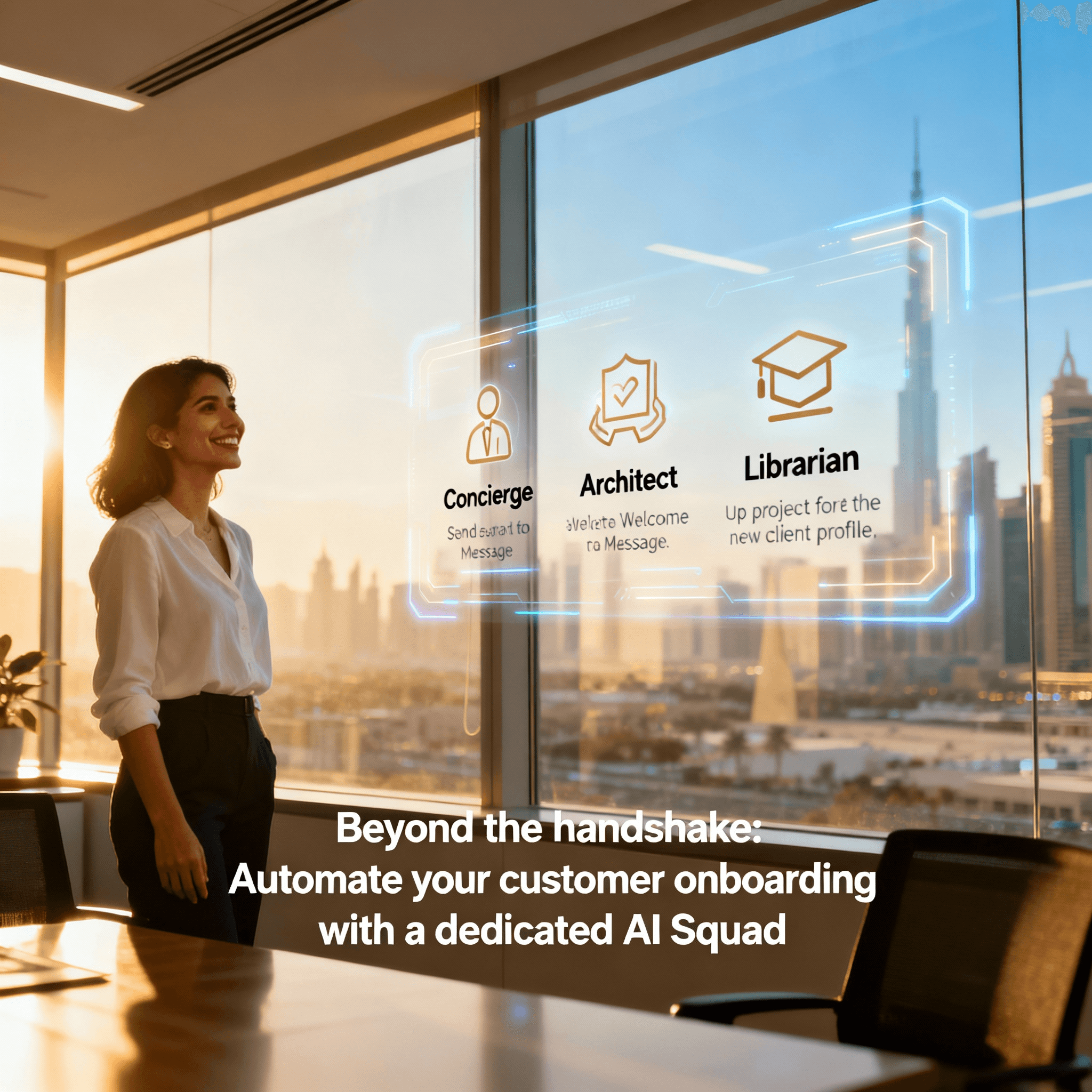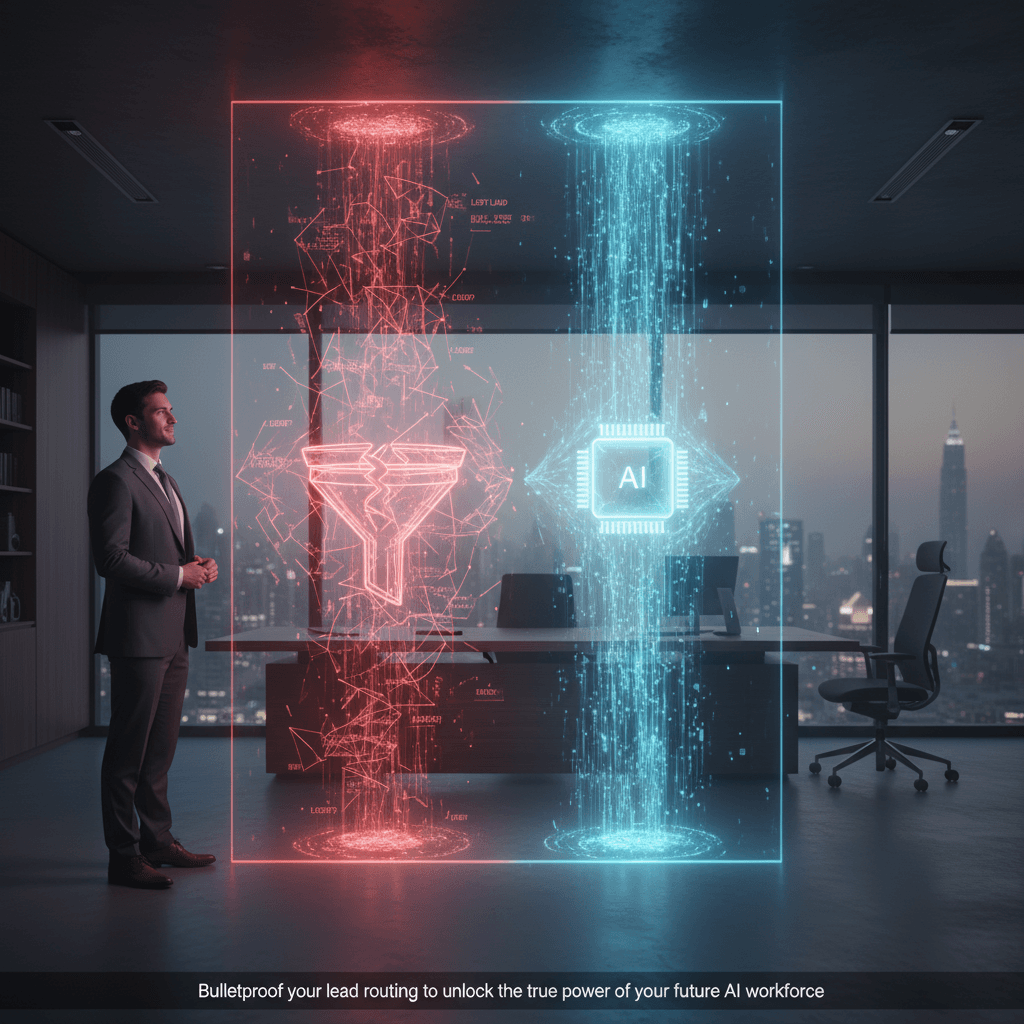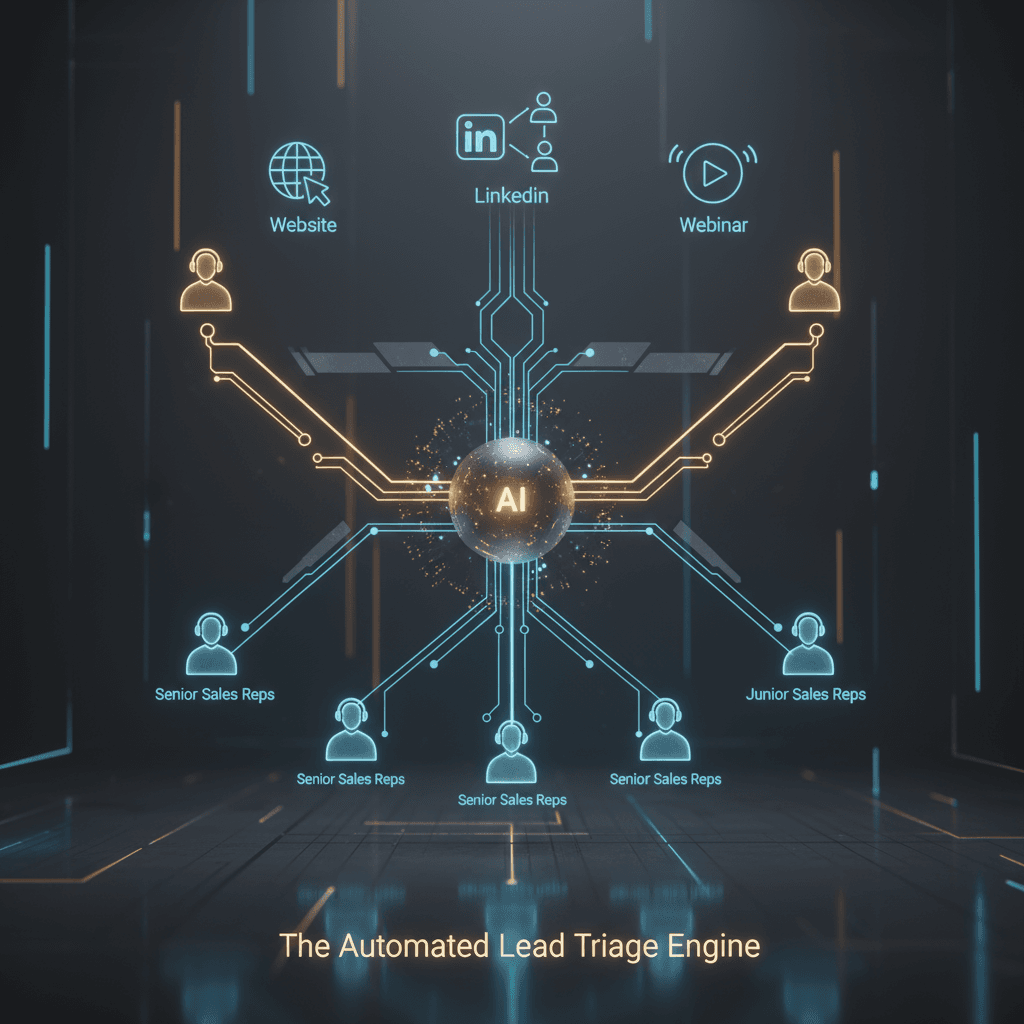Your AI SDR Won the Deal. Now What?
You’ve invested heavily in an AI workforce to qualify leads and book demos, and it’s working. Deals are closing faster than ever. But this new velocity has exposed a painful bottleneck: the handover. The moment a client says “yes,” they fall into a manual vortex of welcome emails, scheduling conflicts, and spreadsheet-based checklists. This friction kills the momentum you worked so hard to build and delays their time-to-value.
Instead of a seamless transition, your team is stuck with administrative drag, and your new client is left wondering if they made the right choice. It’s time to automate the post-sale experience with the same intelligence you apply to the pre-sale process. This playbook shows you how to build a multi-agent “AI Onboarding Squad” that delivers a flawless, high-touch welcome every single time.
Key Takeaways: How an AI Onboarding Squad Helps You Scale
- Shrink Time-to-Value: Take clients from "deal won" to "kickoff call booked" in minutes, not days. We’ve seen clients cut their initial onboarding timeline by over 70%.
- Eliminate Manual Errors: Ensure every client gets the same, high-quality experience. No more missed steps, forgotten welcome packets, or incorrect project setups.
- Free Up Your Team: Automate the 80% of onboarding that is administrative work. Your account and project managers can now focus on strategy and building human relationships.
- Create a “Wow” Moment: An instant, personalized welcome on WhatsApp followed by an immediate calendar link makes a powerful first impression that sets the tone for the entire relationship.
- Build a Scalable Engine: Onboard 5 clients or 50 with the same lean team. Your process for delivering value can finally keep pace with your sales growth.
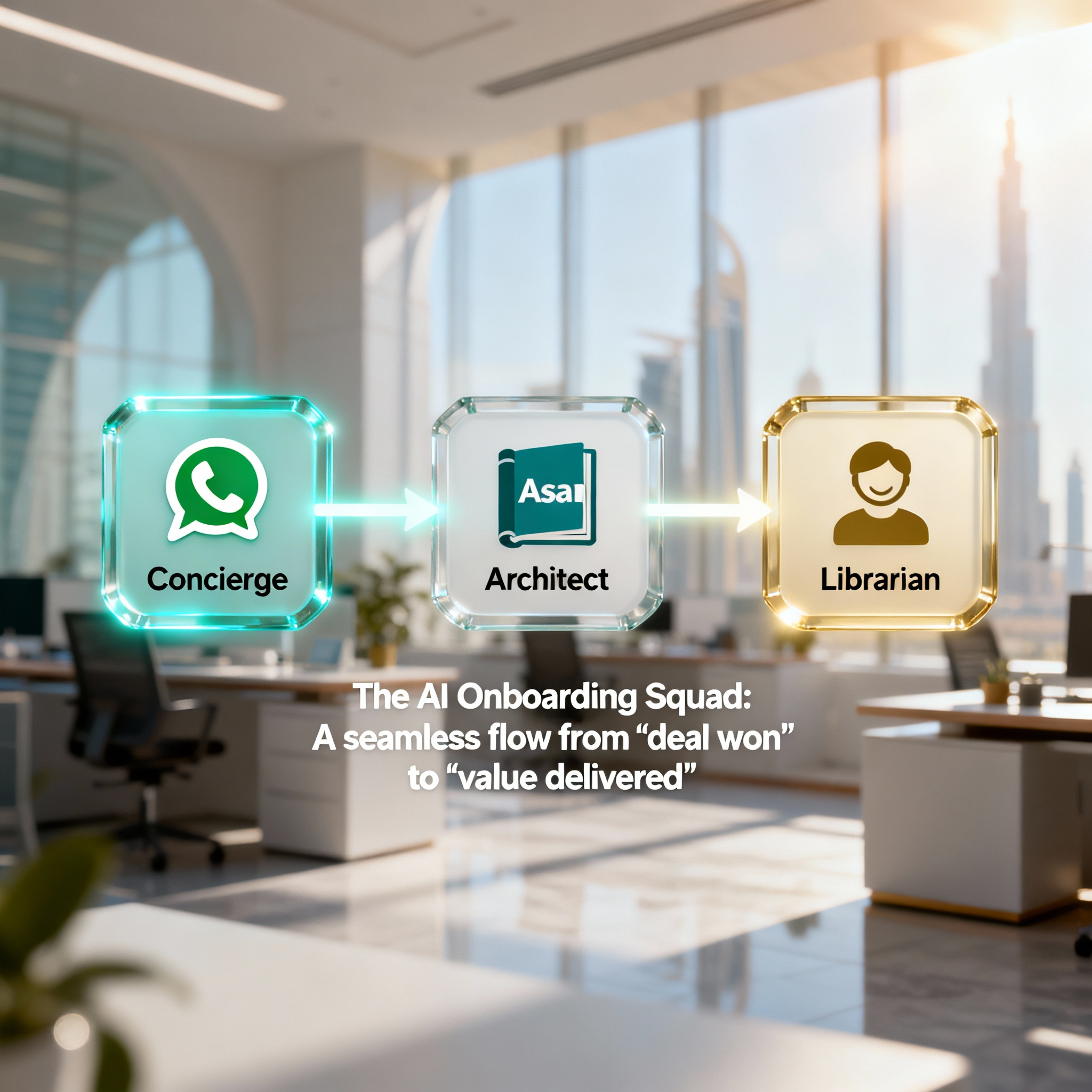
Meet Your AI Onboarding Squad: A 3-Agent Framework
A single tool or chatbot can't manage a complex process like onboarding. The solution is a coordinated, multi-agent system where specialized AIs handle distinct tasks in a sequence. Think of it as your own digital operations team that works 24/7. Here’s how to structure your squad using an orchestration tool like n8n or Make.com.
1. The "Concierge" Agent: The Perfect First Impression
The moment the deal is marked "Closed Won" in your CRM, the Concierge springs into action. Its only job is to provide a warm, immediate, and helpful welcome.
- Trigger: Deal stage changes in HubSpot or Salesforce.
- Actions:
- Pulls the new client’s name, company, and phone number from the CRM record.
- Sends a personalized welcome message via the WhatsApp Cloud API. In the UAE, this is a critical, high-engagement channel that cuts through email noise.
- Includes a unique Cal.com link for the client to book their kickoff call instantly, without any back-and-forth.
- Before-and-After: From a 2-day email chain to book a meeting, to a kickoff call scheduled in under 5 minutes post-signature.
2. The "Architect" Agent: Building the Foundation
Once the kickoff call is booked, the client has taken their first action. The Architect’s job is to use that signal to prepare everything your internal team needs for a successful project launch.
- Trigger: A new event is created in Cal.com.
- Actions:
- Creates a new client project in Asana or Notion by cloning a master template.
- Assigns initial internal tasks like "Prepare kickoff deck" or "Review client discovery notes."
- Generates a shared Google Drive or SharePoint folder structure for all project assets.
- Notifies the assigned Account Manager via Slack or Teams that the project is set up and ready.
- Before-and-After: From 45 minutes of manual setup per client, to a fully provisioned project in under 30 seconds.
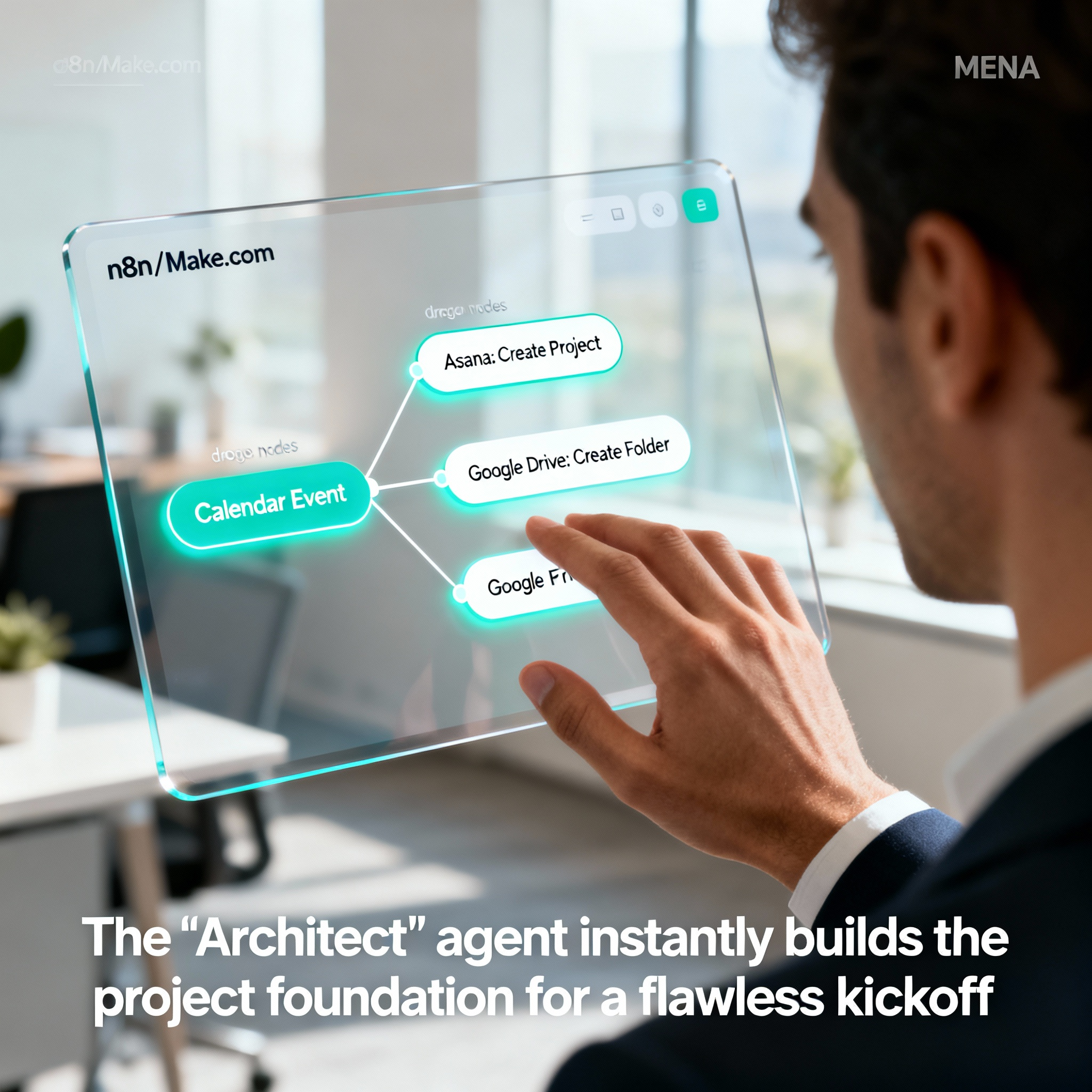
3. The "Librarian" Agent: Proactive, 24/7 Support
The Librarian works in the background during the early stages of the client relationship, deflecting common questions and empowering clients to find answers themselves. This agent reduces the burden on your support and success teams.
- Trigger: Monitors a dedicated client email inbox or shared Slack channel for specific keywords ("how to," "where can I find," "password," etc.).
- Actions:
- Uses an AI model to understand the intent of the client's question.
- Searches a knowledge base (like a Notion database or your help center) for the most relevant article or guide.
- Replies instantly with the direct link to the resource.
- Before-and-After: Reduces repetitive first-week support tickets by an estimated 25-40%, letting your team focus on strategic adoption rather than basic setup queries.
The Tech Stack To Power Your Squad
This entire system is built with off-the-shelf tools, connected by a central automation platform. You don't need a team of developers to wire it together.
- CRM (The Trigger): HubSpot or Salesforce is your source of truth.
- Orchestrator (The Brain): Tools like n8n or Make.com act as the central nervous system, connecting the triggers and actions for each agent.
- Communication (The Voice): The WhatsApp Cloud API is perfect for high-priority messages in the UAE market. You can learn more about this in our HubSpot to WhatsApp playbook.
- Scheduling & PM (The Hands): Cal.com, Asana, Notion, and Google Drive are the tools that execute the tasks.
Frequently Asked Questions
- How do I automate the customer onboarding process?
- Start by mapping your current manual process. Then, use an orchestration tool like n8n to connect your CRM (e.g., HubSpot) to your communication and project management tools. The "AI Onboarding Squad" framework (Concierge, Architect, Librarian) is a great model to follow.
- What is the best workflow for new customer onboarding?
- A great workflow prioritizes speed and clarity. It should include: 1. An instant welcome message. 2. A simple way to book the first call. 3. A clear project plan or checklist. 4. Proactive delivery of key resources. 5. A defined feedback loop.
- How can AI improve customer onboarding?
- AI eliminates manual data entry, ensures consistency, provides 24/7 responses to common questions, and personalizes communication at scale. This reduces human error and frees up your team to focus on strategic client success, not administrative tasks.
- What's the difference between an AI agent and a simple chatbot?
- A simple chatbot typically follows a rigid, pre-defined script. An AI agent is a more autonomous system that can be triggered by events in other applications (like a CRM), execute multi-step actions across different platforms (like creating a project in Asana), and make simple decisions based on the data it receives.
- How do you use WhatsApp for customer onboarding?
- WhatsApp is ideal for the initial welcome message, sending a booking link for the kickoff call, and providing critical, time-sensitive updates. Its high open rates in regions like the UAE make it far more effective than email for the first touchpoint post-sale.
- What metrics should I track for customer onboarding success?
- Key metrics include: Time-to-Value (TTV), time to complete onboarding, product adoption rate, number of support tickets in the first 30 days, and the client's initial Net Promoter Score (NPS) or customer satisfaction (CSAT) score.
- How do you reduce time-to-value for new customers?
- Automation is key. By automating the kickoff call scheduling, project setup, and initial resource sharing, you remove dead time and administrative friction from the process. This gets the client engaged and using your product or service faster.
Your 3-Step Action Plan to Get Started
Building a full AI squad may seem daunting, but you can start small and get your first agent live in a week. Follow these steps:
- Map Your Current Onboarding Journey: Grab a whiteboard and chart every single step from "deal won" to "project kickoff." Identify the single biggest delay or manual bottleneck. This is your starting point.
- Launch Your "Concierge" Agent First: Automating the welcome message and scheduling link is the highest-impact, lowest-effort first move. It solves the biggest initial friction point and delivers an immediate "wow" moment for your new client.
- Build With an Expert Partner: If you want to design and deploy a robust multi-agent system without the trial and error, it helps to work with a team that specializes in it. Learn more about how we build AI workforces that deliver measurable business outcomes.
